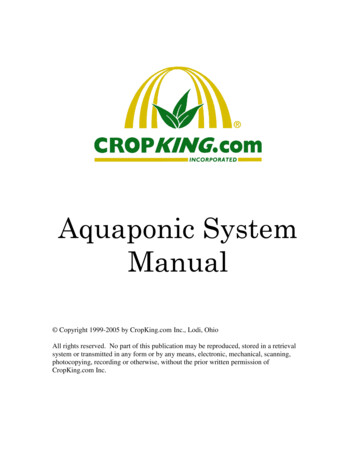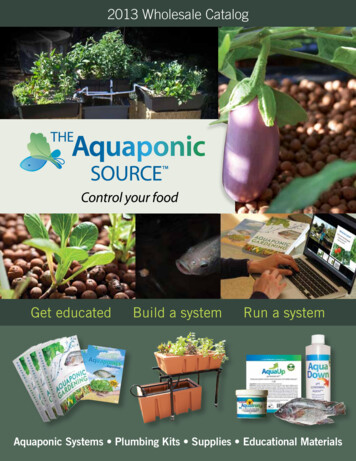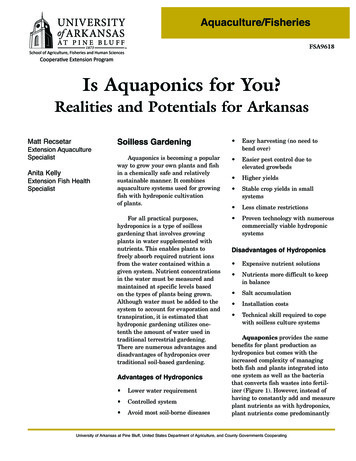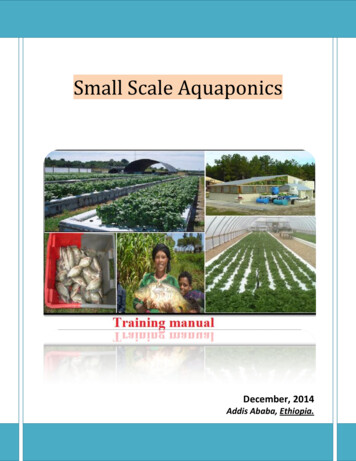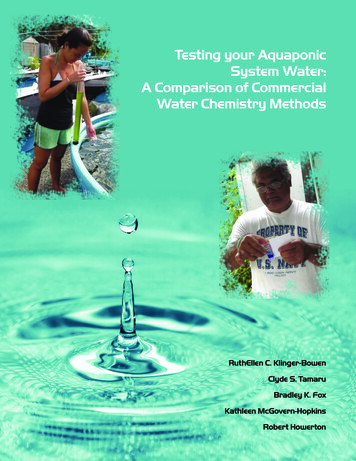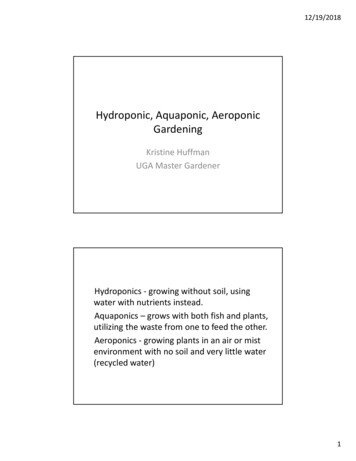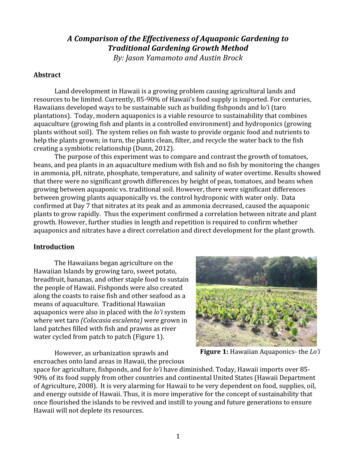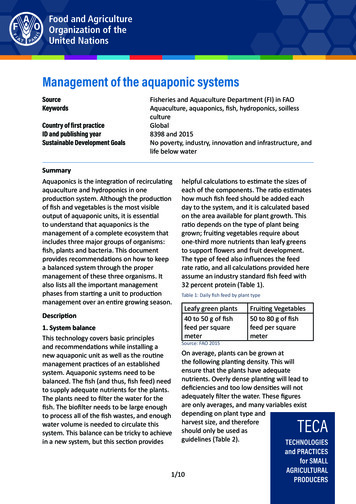
Transcription
Management of the aquaponic systemsSource Fisheries and Aquaculture Department (FI) in FAOKeywords Aquaculture, aquaponics, fish, hydroponics, soillesscultureCountry of first practiceGlobalID and publishing year8398 and 2015Sustainable Development GoalsNo poverty, industry, innovation and infrastructure, andlife below waterSummaryAquaponics is the integration of recirculatingaquaculture and hydroponics in oneproduction system. Although the productionof fish and vegetables is the most visibleoutput of aquaponic units, it is essentialto understand that aquaponics is themanagement of a complete ecosystem thatincludes three major groups of organisms:fish, plants and bacteria. This documentprovides recommendations on how to keepa balanced system through the propermanagement of these three organisms. Italso lists all the important managementphases from starting a unit to productionmanagement over an entire growing season.Description1. System balanceThis technology covers basic principlesand recommendations while installing anew aquaponic unit as well as the routinemanagement practices of an establishedsystem. Aquaponic systems need to bebalanced. The fish (and thus, fish feed) needto supply adequate nutrients for the plants.The plants need to filter the water for thefish. The biofilter needs to be large enoughto process all of the fish wastes, and enoughwater volume is needed to circulate thissystem. This balance can be tricky to achievein a new system, but this section provideshelpful calculations to estimate the sizes ofeach of the components. The ratio estimateshow much fish feed should be added eachday to the system, and it is calculated basedon the area available for plant growth. Thisratio depends on the type of plant beinggrown; fruiting vegetables require aboutone-third more nutrients than leafy greensto support flowers and fruit development.The type of feed also influences the feedrate ratio, and all calculations provided hereassume an industry standard fish feed with32 percent protein (Table 1).Table 1: Daily fish feed by plant typeLeafy green plants40 to 50 g of fishfeed per squaremeterSource: FAO 2015Fruiting Vegetables50 to 80 g of fishfeed per squaremeterOn average, plants can be grown atthe following planting density. This willensure that the plants have adequatenutrients. Overly dense planting will lead todeficiencies and too low densities will notadequately filter the water. These figuresare only averages, and many variables existdepending on plant type andharvest size, and thereforeshould only be used asguidelines (Table 2).TECHNOLOGIES1/10TECAand PRACTICESfor SMALLAGRICULTURALPRODUCERS
Fishery and Aquaculturemore complex filtration system to deal withthe solid waste (Table 4).Table 2: Planting density by plant typeLeafy green plants20 to 25 g of fishfeed per squaremeterFruiting Vegetables4 plants per squaremeterTable 4: Fish stocking densityFish stocking density10 to 20 kg of fish per 1 000 litre of waterSource: FAO 2015On average, the fish will consume 1 to2 percent of their body weight per day duringthe grow-out stage. This assumes that thefish are larger than 50 g because small fisheat more than large ones, as a percentage ofbody weight (Table 3).Table 3: Fish feeding rateFish feeding rate1 to 2 percent of total body weight per daySource: FAO 2015The recommended maximum stockingdensity is 20 kg of fish for 1 000 litres ofwater (fish tank). The small-scale unitsdescribed in this publication have about1 000 litres of water and should contain 10 to20 kg of fish.Higher stocking densities require moresophisticated aeration techniques to keepthe DO levels stable for fish, as well as aSource: FAO 2015Table 5 summarizes the key figures and ratiosfor designing small-scale media bed, NFT andDWC units. It is important to be aware thatthe figures are just guides as other externalfactors (climate conditions, access to aconstant supply of electricity for example)may change the design on the ground. Pleasenote the footnotes below explaining thefigures and the applicability of each columnper aquaponic method. The recommended fish density is based ona maximum stocking density of 20 kg per1 000 litres. Higher densities are possiblewith further aeration and mechanicalfiltration, but this is not recommended forbeginners. The recommended feeding rate is1 percent of body weight per day for fishof more than 100 g of body mass. Thefeeding rate ratio is 40 to 50 g per m² forTable 5: Practical system design guide for small scale unitsFish tank Max. fishPumpFeed ratevolume biomassflow rate(g/day)(Litre)(kg)(litre/h)2005001 0001 5002 0003 000Source: FAO 201551020304060501002003004006008001 2002 0002 5003 2004 400-5002/10Min. volume ofPlant growingbiofilter mediaarea 001506400200860030012
leafy greens; and 50 to 80 g per m² forfruiting vegetables. The volumes for mechanical separatorand biofilter should be 10 to 30 percent oftotal fish tank volume. In reality, the choiceof containers depends on their size, costand availability. Biofilters are only neededfor NFT and DWC units. Mechanicalseparators are applicable for NFT, DWCunits and media bed units with a fishdensity of more than 20 kg per 1 000 litres. These figures assume the bacteria are inoptimal conditions all the time. If not, fora certain period (winter), extra filtrationmedia may need to be added as a buffer.Different values are provided for the twomost common biofilter media based ontheir respective specific surface area. Figures for plant growing space includeonly leafy greens. Fruiting vegetableswould have a slightly lower area.In addition, daily health monitoring of thefish and the plants will provide feedbackon the balance of the system. Disease,nutritional deficiencies and death aresymptoms of an unbalanced system. Watertesting will provide information on thebalance of the system. High ammonia ornitrite indicates insufficient biofiltration.Low nitrate indicates too many plants or notenough fish. Increasing nitrate is desirableand indicates adequate nutrients for theplants, though water needs to be exchangedwhen nitrate is greater than 150 mg per litre.2. System cycling and starting a biofiltercolonyBacteria are a crucial and pivotal aspectof aquaponics, serving as the bridge thatconnects the fish waste to the plant fertilizer.The nitrifying bacteria convert the fishwaste, which enters the system mainly asammonia, into nitrate, which is fertilizer forthe plants. This is a two‑step process, andtwo separate groups of nitrifying bacteria areinvolved as shown in Figure 1. Therefore agood establishment of the bacteria colony iscrucial for a new aquaponic system.System cycling is a term that describes theinitial process of building a bacterial colonywhen first starting any aquaponic unit.Under normal circumstances this takes threeto five weeks as cycling is a slow processthat requires patience. Overall, the processinvolves constantly introducing an ammoniasource into the aquaponic unit, feeding thenew bacterial colony, and creating a biofilter.The progress is measured by monitoring thenitrogen levels using the nitrate test kit.Once introduced into the unit, the ammoniabecomes an initial food source for theammonia‑oxidizing bacteria (AOB), a fewof which are naturally occurring and recruitto the system on their own. They can befound on land, in water and in the air. Withinfive to seven days after the first addition ofammonia, the AOB start forming a colonyand begin to oxidize the ammonia intonitrite. Ammonia should be continuously, butcautiously, added to ensure adequate foodfor the developing colony without becomingtoxic. After another five to seven days thenitrite levels in the water will have started torise, which in turn attracts the NOB. As theNitrite‑oxidizing Bacteria (NOB) populationsincrease, the nitrite levels in the water willstart to decline as nitrite is oxidized intonitrate. The end of the cycling process isdefined as when the nitrate level is steadilyincreasing, the nitrite level is 0 mg per litreand the ammonia level is less than 1 mg perlitre. In good conditions, this takes about25 to 40 days, but if the water temperatureis cool, complete cycling may take up to twomonths to finish. At this point, a sufficient3/10
bacterial colony has formed and is activelyconverting the ammonia to nitrate.The reason this process is long is becausenitrifying bacteria grow relatively slowly,requiring 10 to 15 hours to double inpopulation. However, some heterotrophicbacteria can double in as little as 20 minutes.Alternatively, if another aquaponic systemis available, it is extremely helpful to sharepart of the biofilter as a seed of bacteria forthe new system. This greatly decreases thetime necessary for cycling the system. It canalso be useful to separately start a biofiltermedium by continuously trickling a solutioncontaining 2 to 3 mg per litre of ammoniafor a few weeks in advance. The mediawould then function as a primer by simplyincorporating it into the new aquaponicbiofilter. FAO/TECAFigure 2. Levels of ammonia, nitrite and nitrate during thefirst few weeks in a recirculating aquaculture system FAO/TECAFigure 1. The nitrification process in aquaponics3. Management practices for plantsSeedlings can be planted into the system assoon as nitrates are detected. Expect thesefirst plants to grow slowly and exhibit sometemporary deficiencies because the nutrientsupply in the water is temporarily small.It is recommended to wait three to fourweeks to allow the nutrients to accumulate.In general, aquaponic systems show a slightlylower growth rate than soil or hydroponicproduction in the first six weeks. However,once a sufficient nutrient base has beenbuilt within the unit (one to three months)the plant growth rates become two to threetimes faster than in soil.4/103.1 Establishing a plant nurseryVegetables are the most important outputfor small‑scale aquaponic production. It isessential that only strong healthy seedlingsare planted. Moreover, the plantingmethods applied must avoid transplantshock as much as possible. Thus, therecommendation is to establish a simpleplant nursery to ensure an adequate supplyof healthy seedlings ready to be plantedinto the aquaponic units. It is always bestto have an excess of plants ready to go intothe system, and often waiting for seedlingsis a source of production delay.A simple nursery bed can be constructedusing horizontal wood lengths lined withpolyethylene liner. Water is pumped intothe bed for about half an hour each day(controlled by a simple electric timer),allowing water and moisture to soak intothe growing media. The water is then slowlydrained down into a tank below. This cycleis repeated daily in order to prevent waterlogging of the seedlings. Too much moistureincreases the threat of fungal infections.Polystyrene propagation trays are placedinto the nursery bed and are filled with soil,inert grow media such as rockwool, peat,
coco fibre, vermiculite, perlite or a pottingmix with a combination of the various typesof growing medium. Simpler alternativesfor propagation trays are also possibleusing recyclable materials such as emptyegg boxes. Choose propagation trays thatallow adequate distance between seedlingsin order to favour good growth withoutcompetition for light.3.2 Direct seeding in media bedsIt is possible to sow seeds straight intothe media bed. If using a flood–and drainmechanism (e.g. bell siphon) the seeds maybe washed around. Therefore, the siphonshould be removed while sowing seeds inthe bed, and then replaced when the firstleaves begin to appear.3.3 Transplanting seedlingsTransplanting seedlings obtained from soilbeds is not recommended. It should onlybe done if strictly necessary. In this case,all of the soil needs to be washed out fromthe root system very gently because it maycarry plant pathogens. This washing processis very stressful for seedlings and it ispossible to lose four to five days of growthas the plant adjusts to new conditions.Thus, it is preferable to start seeds usinginert media (rockwool, vermiculite or cocofibre) in propagation trays as explainedabove. In this way, the seedlings can betransplanted with minimal shock.Larger plants from pots can also beplanted, although again the soil needs tobe removed. Avoid transplanting in themiddle of the day because plant roots areextremely sensitive to direct sun light andleaves can face water stress due to the newgrowing conditions. It is recommendedto plant at dusk so the young seedlingshave a night to acclimatize to their newenvironment before the morning sun.5/103.4 During planting3.4.1 Plant selectionIt is best to start a new aquaponic systemwith fast-growing robust plants with alow nutrient demand. Some examples areleafy green vegetables, such as salads,or nitrogen fixing plants, such as beansor peas. After two to three months,the system is ready for larger fruitingvegetables that demand a greater amountof nutrients. Please see further readingsection to find a list of potential plantsto be used in aquaponics, “Small-scaleaquaponic food production - Integratedfish and plant farming (FAO, 2014)” page169 - 181.3.4.2 Plant spacingSeedlings can be planted using a slightlydenser spacing than for most vegetablesin soil because in aquaponics the plantsdo not compete for water and nutrients.Even so, the plants still need enough roomto reach their mature size and to avoidreciprocal competition for light, whichwould depress their marketable quality orfavour vegetative growth instead of fruits.In addition, consider shading effects ofthe full-grown plants, which allows for thecontemporary cropping of shade-tolerantspecies next to taller plants.3.4.3 Supplementing ironSome new aquaponic units experienceiron deficiencies in the first two to threemonths of growing as iron is importantduring the early stages of plant growth andis not abundant in fish feed. Thus, it maybe necessary to initially add chelated iron(soluble iron in powder form) to the unitto meet the requirements for plants. Therecommendation is to add 1 to 2 mg perlitre for the first three months of startinga unit, and again when iron deficiencies
are present. Chelated iron can be boughtfrom agricultural suppliers in powderform. Iron can also be supplemented byusing aquaponics-safe organic fertilizerssuch as compost or seaweed tea, as iron isabundant in both.3.5 Harvesting plantsIn one to two months, leafy greenvegetables should be ready to harvest. Afterthree months, the unit should also haveenough of a nutrient base to begin plantinglarger fruiting vegetables.The following points detail the finalguidelines for growing plants after the initialthree-month period.3.5.1 Staggered planting and harvestingIt is worth staggering the planting overtime in order to prevent harvesting theentire crop all at once. If this were tohappen, nutrient levels would decreasejust before harvest, which might createnutritional problems for the plants, andspike after the harvest, which would stressthe fish. Moreover, staggered plantingallows for continual harvest and transplantof vegetables and ensures constantnutrient uptake and water filtration.3.5.2 Harvesting approachesWhen harvesting full plants from mediabeds (e.g. lettuce), make sure the entireroot system is removed. In addition, shakethe gravel stuck in between the roots andplace the gravel back in the media bed.In NFT and DWC pipes / canals also makesure the whole root system is removed.Place the discarded plant roots into acompost bin to recycle the plant waste.Leaving roots and leaves in the systemcan encourage disease. When harvestingvegetables use a sharp clean knife. Toprevent any bacteria contamination,6/10ensure that aquaponic water does not wetthe leaves. Place harvested plants into aclean bag and wash and chill the crops assoon as possible to maintain freshness.3.6 Managing plants in mature systems3.6.1 Stabilizing pHIt is vital for good plant growth to maintainthe pH between six and seven, so plantshave access to all the nutrients available inthe water. Add small amounts of base orbuffer whenever the pH approaches6.0 in order to maintain optimum pHlevels. Add rainwater or correct withacid any alkalinity-rich water only if thehardness level in the aquaponic systemis too high to prevent nitrifying bacteriafrom naturally lowering the pH to optimallevels. Treat the water with acid outsidethe aquaponic system, and pour the waterinto the system after checking the pH.3.6.2 Plant nutritionSuccessful aquaponic systems arebalanced. The feed rate ratio is the mainguideline to balance the amount offish feed to plant growing area, whichis measured in grams of daily feed persquare metre of plant growing space.The feed rate ratio for leafy vegetables is20 to 50 g per m² daily; fruiting vegetablesrequire 50 to 80 g per m² daily.3.6.3 Organic fertilizersIf deficiencies do occur, it is necessaryto add outside nutrients. Organic liquidfertilizer can be used as either dilutedfoliar feed for plant leaves or pouredstraight into the root zone.Compost tea and seaweed tea arerecommended. Deficiencies often occurwhen there are too many plants for thenumber of fish, or when feeding is reducedduring winter months. Before adding
fertilizers, be sure to check pH to makesure there is no nutrient lockout.3.6.4 Pests and diseaseBe sure to try to prevent pests usingthe integrated production and pestmanagement (IPPM) techniques (e.g.physical barriers, trapping, companionplanting, crop rotation, among others). Ifpests remain a problem, begin by usingthe mechanical removal techniquesbefore considering sprays. Only useaquaponic‑safe remedies, such asplant extracts or repellents, biologicalinsecticides (Bacillus thuringiensis andBeauveria bassiana), soft soaps, ash,plant oils or extracts of essential oils,chromatic/attractant traps, and externalattractant plants treated with insecticides.Regardless, avoid letting the spray enterthe water.3.6.5 Follow seasonal planting adviceTo an extent, aquaponic food productionmethods provide a means to extendplanting seasons, particularly if the unitis housed inside a greenhouse. However,it is still strongly recommended to followlocal seasonal planting advice. Plants growbetter in the season and environmentalconditions to which they are adapted.4. Management practices for fishAs it is recommended for the plants, it isbest to wait until the initial cycling processis totally completed and the biofilter is fullyfunctioning to add the fishes to the system. Ifit is decided to add fish before cycling, thena reduced number of fish should be added.This time will be very stressful for the fish,and water changes may be necessary.4.1 Fish selectionSeveral fish species have recorded excellentgrowth rates in aquaponic units. Fish7/10species suitable for aquaponic farminginclude tilapia, common carp, silver carp,grass carp, barramundi, jade perch, catfish,trout, salmon, Murray cod, and largemouthbass. It is also important to be aware oflocal regulations governing the importationof any new species. Exotic (e.g. non-native)species should never be released into localbodies of water. Local extension agentsshould be contacted for more informationregarding invasive species and nativespecies suitable for farming.For more details, please go to furtherreading section and check the listof potential fish species to be used inaquaponic, “Small-scale aquaponic foodproduction - Integrated fish and plantfarming (FAO, 2014)” page 110 - 116.4.2 Acclimatizing fishThe fish must be properly acclimatizedto the new water. Acclimatizing fish intonew tanks can be a highly stressful processfor fish, particularly the actual transportfrom one location to another in bags orsmall tanks. There are two main factorsthat cause stress when acclimatizing fish:changes in temperature and pH betweenthe original water and new water. If the pHvalues are more than 0.5 different, then thefish will need at least 24 hours to adjust.Keep the fish in a small aerated tank of theiroriginal water and slowly add water fromthe new tank over the course of a day. Evenif the pH values of the two environmentsare fairly close, the fish still need toacclimatize. The best method to do this is toslowly allow the temperature to equilibrateby floating the sealed transportation bagscontaining the fish in the culture water. Thisshould be done for at least 15 minutes.At this time small amounts of water shouldbe added from the culture water to the
transport water with the fish. Again, thisshould take at least 15 minutes so as toslowly acclimatize the fish. Finally, the fishcan be added to the new tank.4.3 Fish feeding and growth ratesThe feed rate ratio provides a way tobalance the components of an aquaponicsystem, and to calculate planting area, fishfeed, and fish biomass.In the cases of the fish, the feed rate variesaccording to the fish growth stage. During the grow-out stage of the fish, itis recommended a fish feeding rate of1 to 2 percent of their body weight perday. Considering a fish stocking density of10 to 20 kg per 1 000 litres, 200 g of feedper day can be provided. During the first two to three months,the fish are small (50 grams weight for afingerling tilapia) and eat about 3 percentof their body weight per day. Therefore,an initial stocking of 40 fingerlings wouldweigh 2 000 g, and together they wouldeat approximately 60 g of fish feed perday. After two to three months feeding atthis rate, the 40 fish will have grown to80 to 100 grams each and weigh a total of3 200 to 4 000 g. At this point, they shouldbe able to eat 80 to 100 g of feed per day.Make sure to divide the feeding intomorning and afternoon rations. Moreover,juvenile fish benefit from an additionallunch–time feeding. Splitting the ration ishealthier for the fish and also healthier forthe plants, providing an even distributionof nutrients throughout the day. Spreadthe feed across the entire surface of thewater so all the fish can eat without injuringone another or hitting the side of the tank.Avoid scaring the fish during feeding by8/10refraining from sudden movements. Standstill and observe the fish. Always removeany uneaten fish food after 30 minutes, andadjust the next feeding ration accordingly.If there is no food left after 30 minutes,increase the ration. If there is a lot left,decrease the ration. A major indicatorof healthy fish is a good appetite, so it isimportant to observe their general feedingbehaviour. If their appetite declines, or ifthey stop feeding altogether, this is a majorsign that something is wrong with theunit (most probably poor water quality).Moreover, fish appetite is directly related towater temperature, particularly for tropicalfish such as tilapia, so remember to adjustor even stop feeding during colder wintermonths.4.4 Fish healthThe main indicator of fish well-being is theirbehaviour. In order to maintain healthy fish,it is important to recognize the behaviourof healthy fish as well as the signs of stress,disease and parasites. The best time toobserve fish is during their daily feeding,both before and after adding the feed, andnoting how much feed is eaten.4.4.1 Healthy fish exhibit specificbehaviour. Fins are extended, tails are straight. Swimming in normal, graceful patterns.No lethargy. However, catfish often sleepon the bottom until they wake up andbegin feeding. Strong appetite and not shying away atthe presence of the feeder. No marks along the body. No discoloured blotches, streaks or lines. No rubbing or scraping on the sides ofthe tank. No breathing air from the surface. Clear sharp shiny eyes.
4.5 Fish diseasesThe three major groups of pathogens thatcause fish disease are fungus, bacteria andparasites. All of these pathogens can easilyenter an aquaculture system from theenvironment, when adding new fish or newwater, or could have previously existed inthe unit. Prevention is by far the best wayto prevent disease in fish. Daily observationof fish and monitoring for disease allowsthe disease, if present, to be treated quicklyto prevent more fish from being infected.If a significant percentage of fish areshowing signs of disease, it is likely thatthe environmental conditions are causingstress. In these cases, check the levelsof ammonia, nitrite, nitrate, pH andtemperature, and respond accordingly. Ifonly a few fish are affected, it is importantto remove the infected fish immediately inorder to prevent any spread of the diseaseto other fish.One effective treatment options againstsome of the most common bacterial andparasite infections is a salt bath. Infectedfish can be removed from the main fish tankand placed into a salt bath. This salt bathis toxic to the pathogens, but non-fatal tothe fish. The salt concentration for the bathshould be 1 kg of salt per 100 litres of water.Affected fish should be placed in this saltysolution for 20 to 30 minutes, and thenmoved to a second isolation tank containing1 to 2 g of salt per litre of water for anotherfive to seven days. The heating of the waterin the aquaponic system can also shortenthe parasite life cycle and make the salttreatment more effective.Do not use any of the salt bath water whenmoving the fish back into the aquaponicsystem because the salt concentrationswould negatively affect the cultured plants.9/104.6 Harvesting and staggered stockingA constant biomass of fish in the tanksensures a constant supply of nutrients tothe plants. To achieve a constant biomass inthe fish tanks, a staggered stocking methodshould be adopted. This technique involvesmaintaining three age classes, or cohorts,within the same tank. Approximately everythree months, the mature fish (500 g each)are harvested and immediately restockedwith new fingerlings (50 g each). Thismethod avoids harvesting all the fish atonce, and instead retains a more consistentbiomass. If it is not possible to obtainfingerlings regularly, an aquaponic systemcan be still managed by stocking a highernumber of juvenile fish and by progressivelyharvesting them during the season tomaintain a stable biomass to fertilize theplants. If the fish are mixed–sex, the harvestmust firstly target the females to avoidbreeding when they reach sexual maturityfrom the age of five months. Breedingdepresses the whole cohort. In the caseof mixed-sex tilapia, fish can be initiallystocked in a cage and males can then be leftfree in the tank after sex determination.Remember that adult tilapia, catfish andtrout will predate their smaller siblings ifthey are stocked together. A technique tokeep all of these fish safely in the samefish tank is to isolate the smaller ones in afloating frame. This frame is essentially afloating cage, which can be constructed asa cube with PVC pipe used as frame andcovered with plastic mesh. It is importantto ensure that larger fish cannot enter thefloating cage over the top, so make surethat the sides extend at least 15 cm abovethe water level. Each of the vulnerable sizeclasses should be kept in separate floatingframes in the main fish tank. As the fishgrow large enough not to be in danger, they
can be moved into the main tank. With thismethod, it is possible to have up to threedifferent stocking weights in one tank, soit is important that the fish feed pellet sizecan be eaten by all sizes of fish.5. Routine management practices5.1 Daily activities Check that the water and air pumps areworking well, and clean their inlets fromobstructions. Check that water is flowing. Check the water level, and add additionalwater to compensate for evaporation, asnecessary. Check for leaks. Check water temperature. Feed the fish (two to three times a dayif possible), remove uneaten feed andadjust feeding rates. At each feeding, check the behaviour andappearance of the fish. Check the plants for pests. Manage pests,as necessary. Remove any dead fish. Remove any sickplants/branches. Remove solids from the clarifier and rinseany filters.5.2 Weekly activities Perform water quality tests for pH,ammonia, nitrite and nitrate beforefeeding the fish. Adjust the pH, as necessary Check the plants looking for deficiencies.Add organic fertilizer, as necessary. Clear fish waste from the bottom of fishtanks and in the biofilter. Plant and harvest the vegetables, asrequired. Harvest fish, if required. Check that plant roots are not obstructingany pipes or water flow.5.3 Monthly activities Stock new fish in the tanks, if required. Clean out the biofilter, clarifier and all thefilters. Clean the bottom of the fish tank usingfish nets. Weigh a sample of fish and checkthoroughly for any disease.6. Further reading FAO. 2014. Small-scale aquaponic foodproduction - Integrated fish and plantfarming. FAO. 2015. Seven rules-of-thumb to followin aquaponics: URL7. Objectives fulfilled by the project7.1 Women-friendlyThe technology is affordable and easy touse7.2 Resource use efficiencyImproved management of a completeecosystem that includes three major groupsof organisms: fish, plants and bacteria.6.3 Pro-poor technologyThe technology is resilient to poor growingconditions and yields an increase in incomeTECA10/10TECHNOLOGIESand PRACTICESfor SMALLAGRICULTURALPRODUCERS
Aquaponics is the integration of recirculating aquaculture and hydroponics in one production system. Although the production of fish and vegetables is the most visible output of aquaponic units, it is essential to understand that aquaponics is the management of a complete

